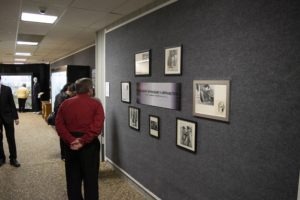
Wayland students Chloe Barham (right) and Devin Davis (center) speak with Plainview Herald Editor Ellysa Harris about their integration exhibit during an opening reception last week. The students researched and designed the exhibit as part of a history practicum course. (Wayland Baptist University Photo)
PLAINVIEW — For Wayland Baptist University history students Chloe Barham and Devin Davis, their history practicum has been practical. The duo chose to build a museum exhibit, focusing on Wayland’s historical decision to integrate in 1951. In the process, however, the students learned far more than the history behind Wayland’s ground-breaking decision.
“We learned a lot about museum politics and museum funding and what goes into making a museum exhibit,” said Barham, a senior humanities and history major from Amarillo. “There’s a lot to consider, like the fact that you need to wear gloves when you handle an artifact and you should change your gloves often.”
Working with Melissa Gonzalez, director of the Llano Estacado and Jimmy Dean museums on the Wayland campus, Davis and Barham discovered that history is brought to life through the museum experience.
“As a historian, I always thought that we write papers, that we don’t do the hands-on things that science majors and engineers get to do,” said Davis, a senior from Opelousas, Louisiana. “But this changed my opinion on that. We do very hands-on things, working in museums, working with artifacts. I learned how to properly deal with all of that. It was a really great experience.”

The experience also led to a comprehensive exhibit currently on display at the Jimmy Dean Museum. Barham and Davis chronical the decision by then Wayland President Dr. James Marshall to allow Annie Taylor, a black school teacher from Floydada, to enroll in classes at Wayland in 1951.
While the decision was met with some controversy, there was actually much more of a positive response than what one might expect. Davis and Barham look at the decision in conjunction with social and cultural expectations of the time period.
Barham said she and Davis chose integration as the topic of their practicum after asking students if they would be interested to find out more about the topic.
“Most of the student around campus, we found out, have heard of the integration, but they have no clue of anything besides that,” Barham said. “They may have heard of the name Annie Taylor, but they don’t really know what it means.”
Barham and Davis also pointed to Wayland’s strong international student presence. At one time, Wayland had a higher percentage of international students than any college or university in the nation.
“That’s something nobody knows when they come to Wayland,” she said.

Barham and Davis hope the exhibit is well received and that people will learn about the history of the university. Mostly, however, they hope people will enjoy the exhibit.
“We don’t want to make an exhibit that nobody wants to see. That’s boring,” Barham said.
The practicum experience has helped shape Barham’s plans for the future. As a result of this experience, she is planning to apply to the museum program at Texas Tech University.
“My passion is public history because I want a lot of people to know about history. I want it to be accessible and I want people to care about it,” Barham said.
The integration exhibit will be on display until the next practicum exhibit is ready in the fall of 2022.
Editor’s Note: This story was provided by Wayland Baptist University.
Correction: A previous version of this story mistakenly reported that Dr. Rebekah Crowe oversaw the students’ practicum. In fact, Barham and Davis worked under the tutelage of Melissa Gonzalez, director of the Llano Estacado and Jimmy Dean museums. The Record regrets the error.


